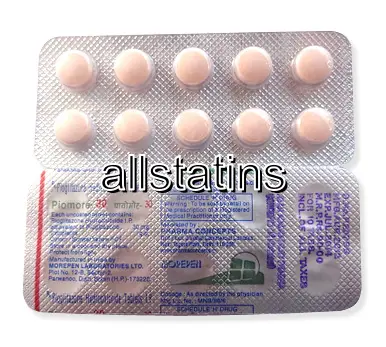| Package | Dosage | Price | Price per Dose | |
|---|---|---|---|---|
| Dosage: 15mg | ||||
| 360 pill | 15mg | NZD681.39 | NZD1.89 | |
| 180 pill | 15mg | NZD368.55 | NZD2.04 | |
| 120 pill | 15mg | NZD266.34 | NZD2.23 | |
| 90 pill | 15mg | NZD213.69 | NZD2.38 | |
| 60 pill | 15mg | NZD154.84 | NZD2.57 | |
| 30 pill | 15mg | NZD89.79 | NZD2.94 | |
| Dosage: 30mg | ||||
| 360 pill | 30mg | NZD1,170.77 | NZD3.25 | |
| 180 pill | 30mg | NZD634.93 | NZD3.53 | |
| 120 pill | 30mg | NZD461.48 | NZD3.84 | |
| 90 pill | 30mg | NZD368.55 | NZD4.09 | |
| 60 pill | 30mg | NZD263.24 | NZD4.37 | |
| 30 pill | 30mg | NZD145.54 | NZD4.83 | |
| 10 pill | 30mg | NZD55.72 | NZD5.42 | |

Pioglitazone Description
Overview of Pioglitazone
Pioglitazone is a medication commonly prescribed to help manage type 2 diabetes mellitus. It belongs to the class of drugs known as thiazolidinediones, which work by increasing the body's sensitivity to insulin. By doing so, Pioglitazone helps control blood sugar levels more effectively, reducing complications associated with high glucose levels. This medication is typically used alongside diet and exercise modifications to improve glycemic control in adult patients.
Mechanism of Action
Pioglitazone functions primarily by activating peroxisome proliferator-activated receptor gamma (PPARγ). Activation of these nuclear receptors influences the transcription of insulin-responsive genes involved in glucose and lipid metabolism. As a result, Pioglitazone enhances insulin sensitivity in adipose tissue, skeletal muscle, and the liver. This action helps decrease insulin resistance, leading to better glucose uptake and utilization, which is essential for effective diabetes management.
Advantages of Using Pioglitazone
Many patients find Pioglitazone to be effective in achieving blood glucose targets. It can be used alone or combined with other antidiabetic drugs, providing flexibility in treatment plans. Unlike some other medications, Pioglitazone generally has a neutral or positive effect on lipid profiles. It can also promote modest weight gain, which, although sometimes viewed as a downside, may be beneficial for certain individuals needing weight stabilization. Another advantage is its potential to improve insulin sensitivity without causing significant hypoglycemia when used as monotherapy.
Possible Side Effects and Risks
Despite its benefits, Pioglitazone is associated with some side effects. The most common include weight gain, edema, and an increased risk of heart failure in susceptible individuals. Patients may also experience headache, respiratory infections, or mild gastrointestinal discomfort. There are concerns about the long-term use of Pioglitazone related to bladder cancer risk, which has prompted careful monitoring by healthcare providers. Liver function tests should be performed regularly, as there is a rare chance of liver toxicity. Understanding these risks is essential before initiating therapy with Pioglitazone.
Considerations and Recommendations
While Pioglitazone is effective, it is not suitable for everyone. Patients with a history of heart failure, active liver disease, or bladder cancer should avoid using this medication. Regular medical checkups are crucial to monitor for potential adverse effects. It is also important to adhere strictly to dosage instructions and report any unusual symptoms to healthcare providers promptly. Combining Pioglitazone with proper diet and physical activity can optimize its benefits, helping patients manage their blood sugar levels more successfully.
Conclusion
In summary, Pioglitazone is a valuable option in the treatment of type 2 diabetes, especially for those needing improved insulin sensitivity. Its mechanism of action offers advantages over some other medications, with a generally tolerable safety profile when used appropriately. Nonetheless, careful patient selection and consistent monitoring are essential to minimize risks and maximize therapeutic benefits in long-term diabetes management.
